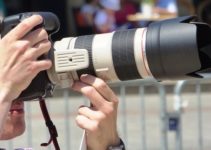Who hasn’t looked up at the stars in wonder? Humanity has been stargazing for thousands of years. The Pyramids of Egypt and Mexico and Stonehenge in Britain are in fact Astronomy devices. However today you need something just a little more portable. If you are planning to stargaze on the go then fixed – telescope devices aren’t the right approach. And a stone monolith won’t fit in your SUV either. So, what are the best stabilized binoculars for astronomy?
- EDITORs TOP3
- Canon 18×50 IS All-Weather Binoculars – EDITOR’s PICK
- Fujinon Techno Stabi TS1440 – EDITOR’s PICK
- Canon 10×30 IS II Binoculars – EDITOR’s PICK
- Fujinon Techno-Stabi TS1228 Image Stabilization Binocular
- ZEISS Optical 20×60 Image Stabilization
Let’s dive in with our top 3 candidates for best image stabilized binoculars for astronomy.
3 Best Binoculars for Astronomy
EDITOR’s PICK |
|---|
1. Canon 18x50 Image Stabilization All-Weather Binoculars |
| «EDITOR’s PICK» |
| Best for high performance |
| Our rating: ⭐⭐⭐⭐⭐ |
 |
Canon’s great optics and the 18x magnification of this weatherproof model makes them top our list. |
| Pros: — High 18x magnification and 50 resolution; — Wide FOV (field of view) as its 3.7 degree angle of view lets you see more of the scene; — Great internal optics with a low MTF distortion (modulation transfer function); — Good weatherproofing; — Comes with a handy bundle including the case, strap & batteries. Cons: — Heavy at just under 2.7 pounds. |
2. Fujinon Techno Stabi TS1440 |
| «EDITOR’s PICK» |
| Best for overall price versus performance |
| Our rating: ⭐⭐⭐⭐⭐ |
 |
Fuji delivers 14 x magnification with outstanding stabilising at a reasonable price. |
| Pros: — Really good 5 degree plus / minus stabilization; — Excellent waterproofing; — Mains power option for long sessions. Cons: — Also heavy at just over 2.7 pounds (a little bit more than the already heavy Canons). |
3. Canon 10x30 Image Stabilization II Binoculars |
| «EDITOR’s PICK» |
| Best compact model |
| Our rating: ⭐⭐⭐⭐⭐ |
 |
When you are after a lightweight and compact model these Canons fit the bill and at a reasonable cost. |
| Pros: — Low weight; — Low cost; — Good internal optics; — Good stabilization. Cons: — 10x magnification is not as effective at long distance viewing. |
Criteria for what binoculars are best for astronomy

With Astronomy, there are straightforward criteria when selecting the best image stabilized binocular. Here are the key ones:
Optical performance and parameters
This is down to magnification, wide angle and objective diameter (which dictates the sharpness or resolution). So, for example, our #1 pick of the Canon 18×50, magnifies by 18 times and has an objective diameter figure of 50. That’s like a really good DSLR zoom in. The #3 pick of the Canon 10×30, magnifies by 10 times and has an objective diameter figure of 30.
- 8×40
- 8×42
- 10×50
- 7×50
- 20×80
- 15×70
The quality of the lenses (how accurately they are ground) also makes a difference, as does the use of special lens coatings to reduce flare and other optical artefacts – although that’s not such an issue for night viewing especially on cloudy nights
Lens coatings that reduce light loss are important too on astronomy models, where low light is the normal viewing situation.
Type of stabilisation
- Active mechanical (battery-powered offset movement of lenses or prisms). This compensates for movement mechanically;
- Passive mechanical (gyroscopic stabilization). This uses the gyroscope effect to physically stabilize the binoculars;
- Digital (motion stabilization based on a static reference point). This complex technique is only found in some digital binoculars.
Size and Weight
All large object diameter binoculars tend to be bulkier and heavier than small object diameter models, which have a ‘small face’. Image stabilization models also tend to be heavier due to the stabilization technology and the need for batteries – up to 4 AA types can be used. If you put these two facts together, you get heavier and bigger than normal binoculars and some are a bit too much for astronomy for children – you’d need to find something a bit lightweight. Small binoculars are generally better and more practical for children’s needs.
Glasses
Some binoculars can be awkward when wearing glasses. Some models are better than others for glasses wearers.
Weather resistance
Weather is always unpredictable, so a water-resistant model is a sensible choice. Some vendors offer fully waterproof models, which is worth thinking about (together with a flotation strap) if you are near or on the water.
Total Cost
Then, of course, there is the cost. It’s worth considering bundles that include accessories. Don’t just go by a headline sticker price – there are packages suited to stargazing which are very affordable because lots of accessories come with them too. You don’t always have to pay top dollar either, just because some website review tells you that you should. There are perfectly good models out there for astronomy which are more suited to a beginner who doesn’t need a high-cost device. Finally, buying online is topical right now, with all the lockdowns going on. So, we recommend looking online and considering a less well-known brand as well as a popular one. Here at USDIGITECH, we really don’t like to make a list that only looks at commonly rated models with top reviews. We believe that everyone is different and that each of us has different needs and varied budgets.
Now let’s look in detail at five candidates for the best choice of stabilized binoculars for astronomy.
Top Rated Image Stabilized Binoculars for Astronomy
1. Canon 18×50 IS Image Stabilization All-Weather Binoculars
Best for high performance

This Canon 18x 50 (model 4624A002) uses a porro prism design. The magnification and sharpness are terrific, like a powerful zoom. You get battery powered stabilization of up to 0.7 degrees, which is good for handheld operation. This is really at the top end for astronomy amateurs and the cost puts it out of the reach of what most beginners are likely to want to pay. It’s a superb example of engineering though and if you have the money – why not?
- High 18x magnification and 50 resolution
- Wide FOV (field of view) as its 3.7 degree angle of view lets you see more of the scene
- Great internal optics with a low MTF distortion (modulation transfer function)
- Good weatherproofing
- Comes with a handy bundle including the case, strap & batteries
- Heavy at just under 2.7 pounds
Verdict: If you have the money to spend, this is a great way to spend it.
2. Fujinon Techno Stabi TS1440
Best for overall price versus performance

These slightly lower priced binoculars from FujiFilm use 4 × AA batteries (two more than the Canons) to deliver a class leading 5 degrees of stabilization at up to 14x magnification. So. you get better stabilization than the Canons but less magnification.
If affordability is important, this Fuji 14×40 set might fit your pocket a little more so than the Canons. They also have the useful feature of a mains power option to save battery life. Their waterproofing is a bit better than the Canons too but their optics -while very good – don’t quite match the Canons, at least in our opinion. They are still a great model and we really like their ergonomics.
- Really good 5 degree plus / minus stabilization
- Excellent waterproofing
- Mains power option for long sessions
- Also heavy at just over 2.7 pounds (a little bit more than the already heavy Canons)
Verdict: If you really want great stabilization, this is the model to go for.
3. Canon 10×30 IS Image Stabilization II Binoculars
Best compact model

If you are looking for a lower cost, rugged design, which is a lightweight and smaller size, these second Canon models are well worth considering. Magnification is a much more modest 10x but battery-powered stabilization is still good at +/- 1 degree and they are less than half the cost of our first two models. Then, add the consideration that these are just 21.2 ounces and you have a very attractive lightweight affordable proposition.
- Low weight
- Low cost
- Good internal optics
- Good stabilization
- 10x magnification is not as effective at long distance viewing
Verdict: If your budget is more modest, these Canons are a logical alternative for astronomy to our first and second choices.
4. Fujinon Techno-Stabi TS1228 Image Stabilization Binocular
Best for astronomy beginners and stargazing kids

Our fourth on the list is this lightweight, compact and lower cost 12×28 model from FujiFilm. It is ideal for beginners or kids and despite the much reduced price, you still get a good looking night sky pictures via the use of proprietary Fujinon lens coatings and phase coated prisms and also a very respectable ±3 degrees of battery powered image stabilization. We really like the one-finger roller bar adjustment too.
- Great low light optics despite the price
- Great stabilization at this price point
- Very lightweight at just 14.9 ounces
- Clever ergonomics
- Internal optics not quite equal to Canon
Verdict: Ideal for astronomy if you want something reasonably priced which still gives great levels of stabilization
5. ZEISS Optical 20×60 Image Stabilization
Best for the astronomy cognoscenti

Our final model is one for those in the know and in the money. Ignore ratings and 3.5-star “average reviews” brought down by those people who probably shouldn’t be buying them anyway. Look at the 5-star reviews of the Zeiss by people in the know.
If you have a lot of cash to spend on astronomy as a hobby, then these Zeiss are the Ferraris or Rolls Royce of image stabilized binoculars. We mean, you don’t buy a Ferraris or Rolls Royce and then complain about the fuel consumption or the lack of a second cupholder on an internet site, do you?
A massive 20x zoom and 60x object diameter delivers stunning images. A Germanic high-precision Gyro delivers amazing stability. What more do you need to know?
- The best optics with the most powerful magnification
- Superbly engineered stabilisation
- Reassuringly expensive
- The price 🙂
Verdict: Like those clothes shops in LA, New York and London that don’t show their prices, if you are concerned about the cost of these Zeiss, then you should just keep quiet and move on. If you have the money, they are absolutely and totally outstanding.
Best Stabilized Binoculars for Astronomy
So, astronomy fans, we have chosen four practical and sensible image stabilized binoculars for astronomy that will do the job nicely. Plus one luxury item we love too.
We hope you have found this list and review useful for your stargazing and please let us know your thoughts in the comments section. Thanks for reading and hope you see that supernova…
Last update on 2024-08-04 / Affiliate links / Images from Amazon Product Advertising API












Canon and others mention lens coatings – can you explain more?
One key difference in brightness between binoculars is the volume of light they deliver to you. When light passes through any lens, some light will bounce back off the surface. So, lens designers put chemical coatings on the lens surfaces to reduce this loss and improve the volume of light. Beginner models have cheaper or less coatings.
Is that the same with the internal optics?
Yes, pretty much. Binoculars have a number of lenses inside, so coatings are popular and can be very important. They can of course increase costs too.